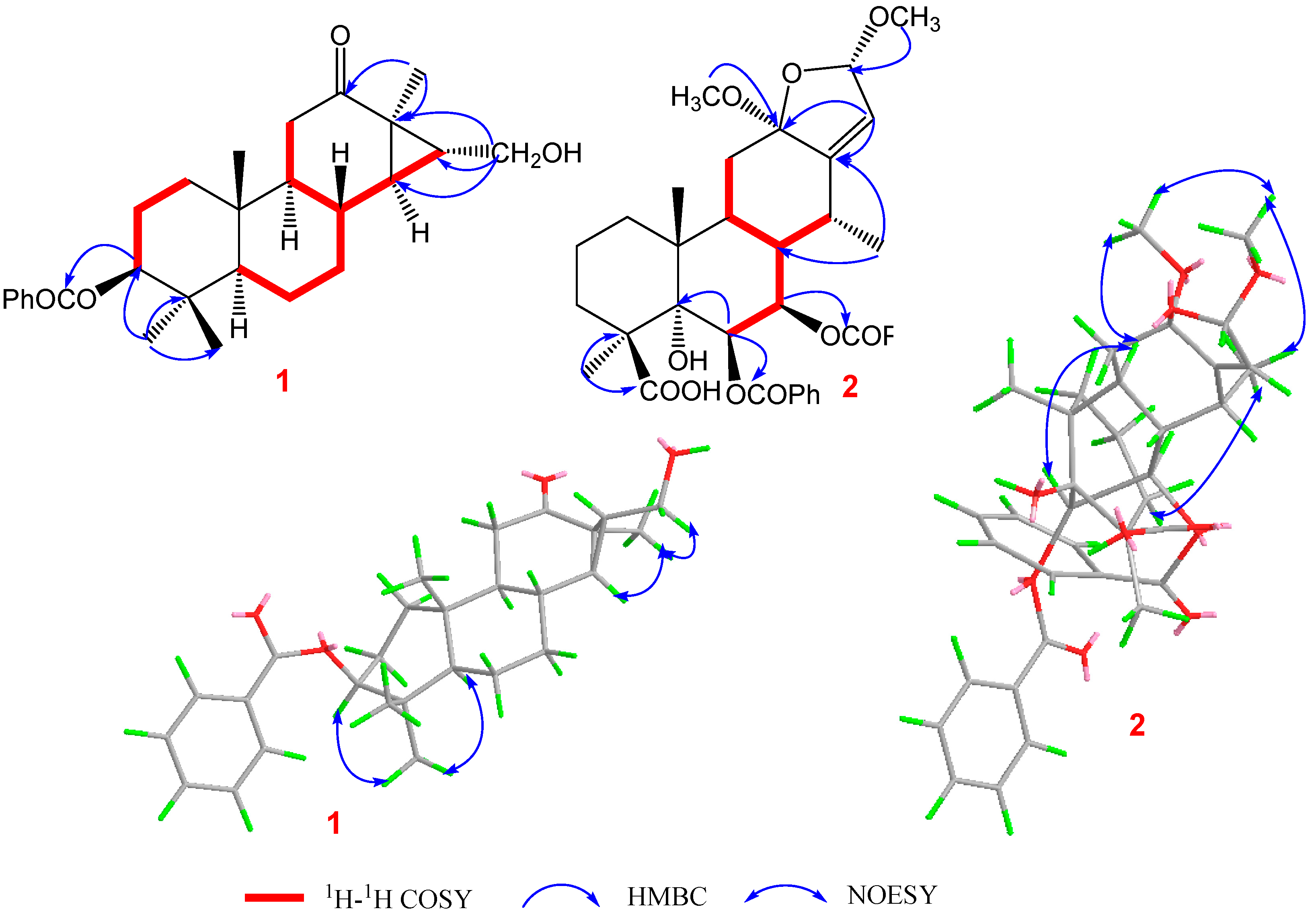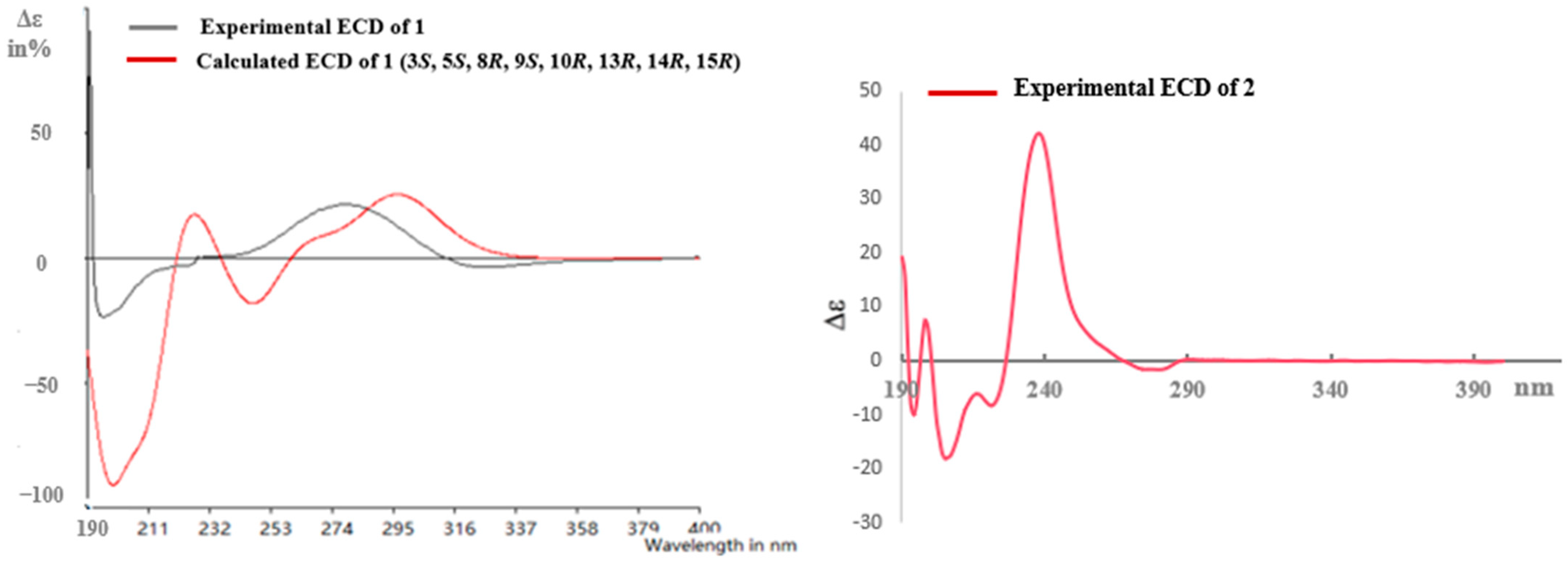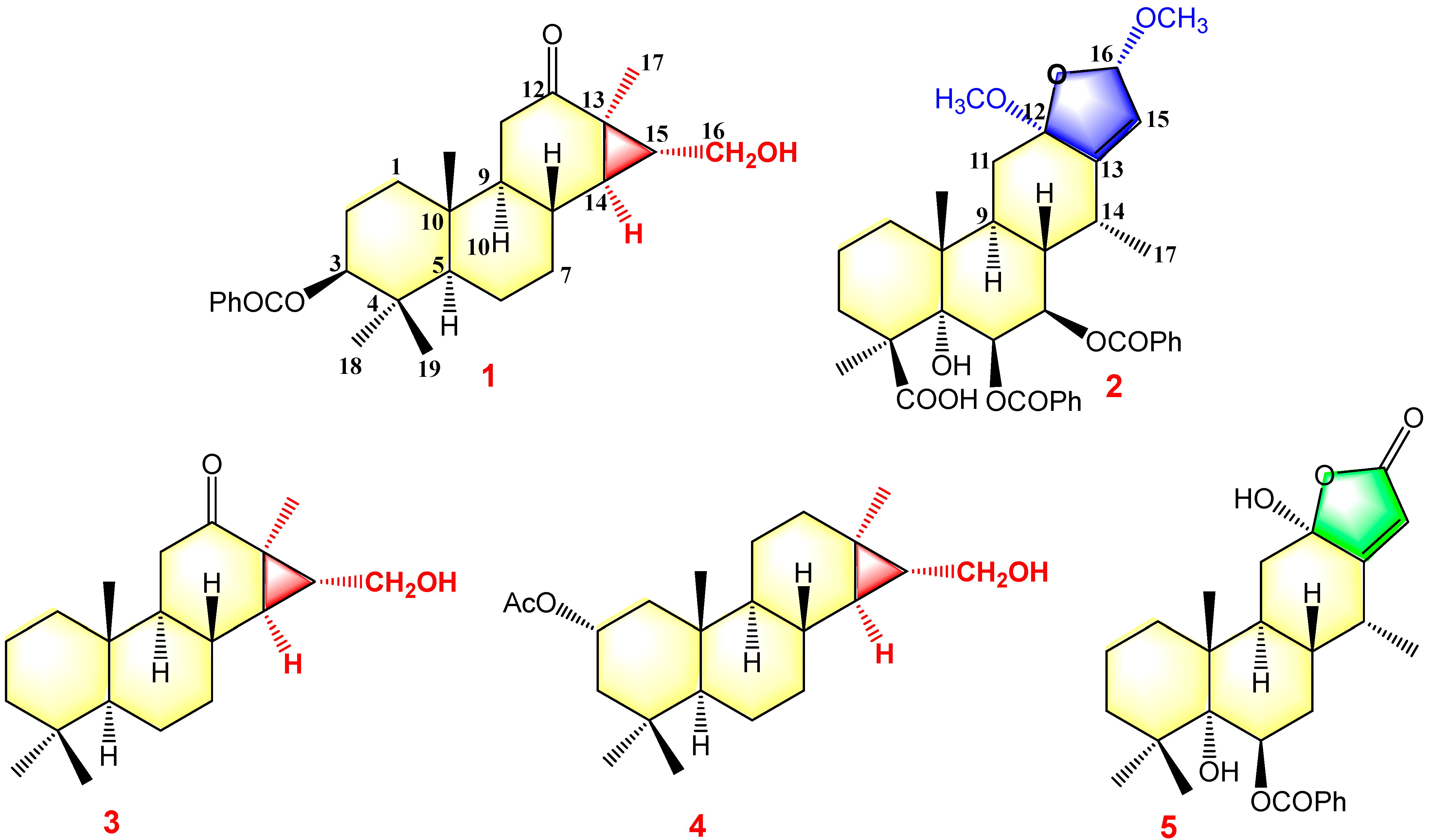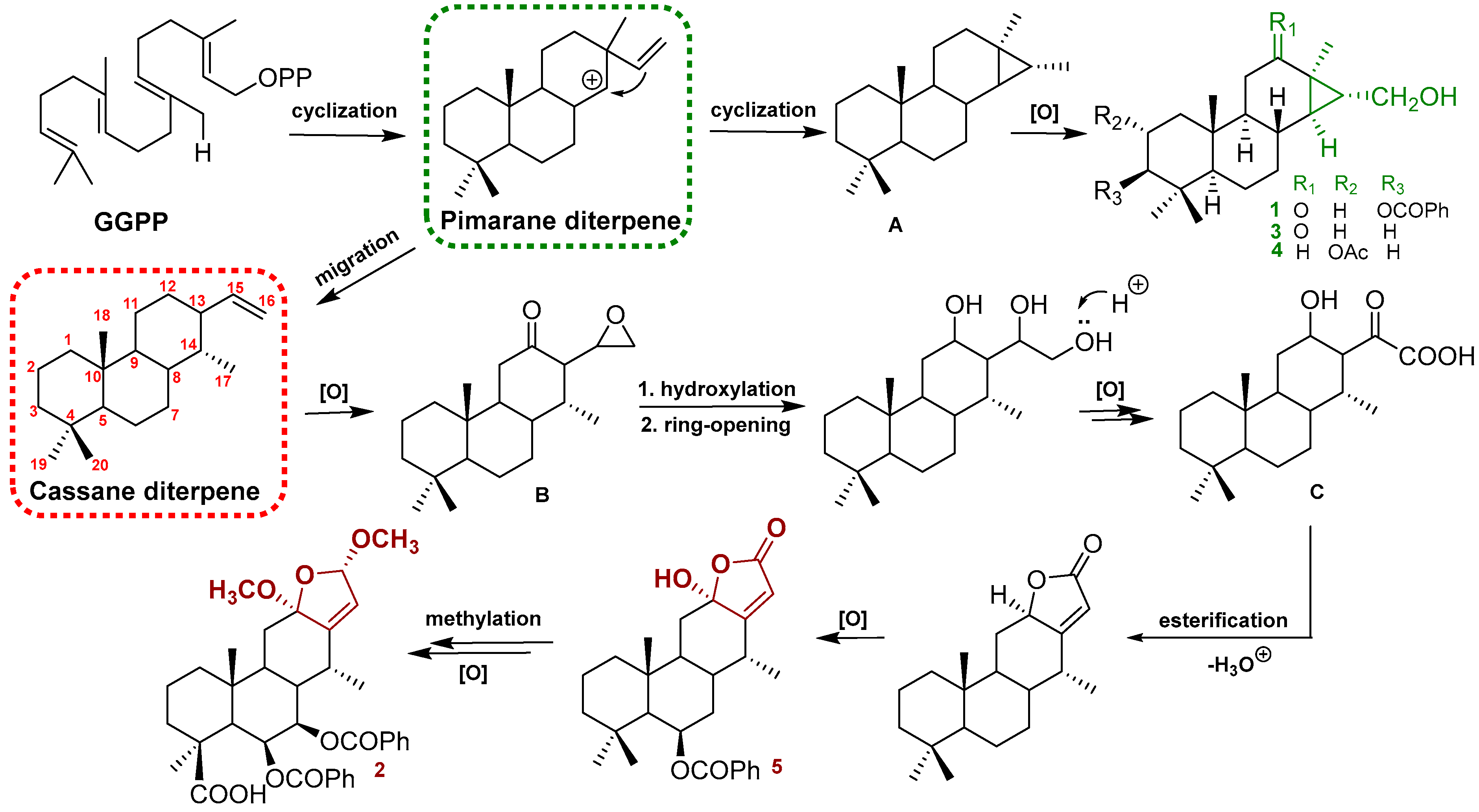Antibacterial Activity of Two New Cassane Diterpenoids from Caesaplinia pulcherrima against Bacillus cereus by Damage to Cell Membrane
Abstract
:1. Introduction
2. Results and Discussion
2.1. Structural Elucidation of the Compounds
2.2. Antibacterial Activity of Compounds 1–5 In Vitro
2.3. Inhibitory Effect of Compound 1 on the Growth of B. cereus and S. aureus
2.4. Effect of Compound 1 on the Cell Membrane Permeability of B. cereus
2.5. Scanning Electron Microscopy (SEM)
3. Materials and Methods
3.1. General Experimental Procedures
3.2. Plant Material
3.3. Extraction and Isolation
3.4. Assay for Antibacterial Activity
3.5. Measurement of the Bacterial Growth Curve
3.6. Measurement of Cell Membrane Permeability
3.7. Scanning Electron Microscopy (SEM)
3.8. Statistical Analysis
4. Conclusions
Supplementary Materials
Author Contributions
Funding
Institutional Review Board Statement
Informed Consent Statement
Data Availability Statement
Conflicts of Interest
References
- Rahnama, H.; Azari, R.; Yousefi, M.H.; Berizi, E.; Mazloomi, S.M.; Hosseinzadeh, S.; Derakhshan, Z.; Ferrante, M.; Conti, G.O. A systematic review and meta-analysis of the prevalence of Bacillus cereus in foods. Food Control. 2023, 143, 109250. [Google Scholar] [CrossRef]
- Zhang, Y.; Chen, J.; Feng, C.; Zhan, L.; Zhang, J.; Li, Y.; Yang, Y.; Chen, H.; Zhang, Z.; Zhang, Y.; et al. Quantitative Prevalence, Phenotypic and Genotypic Characteristics of Bacillus cereus Isolated from Retail Infant Foods in China. Foodborne Pathog. Dis. 2017, 14, 564–572. [Google Scholar] [CrossRef] [PubMed]
- Gao, X.; Swarge, B.N.; Roseboom, W.; Setlow, P.; Brul, S.; Kramer, G. Time-Resolved Proteomics of Germinating Spores of Bacillus cereus. Int. J. Mol. Sci. 2022, 23, 13614. [Google Scholar] [CrossRef] [PubMed]
- Wang, Y.; Zhang, J.; Yuan, Z.; Sun, L. Characterization of the pathogenicity of a Bacillus cereus isolate from the Mariana Trench. Virulence 2022, 13, 1062–1075. [Google Scholar] [CrossRef] [PubMed]
- Thi Hanh Nguyen, V.; Ngoc Son, P.; Phuong Chi, L.; Quynh Anh, P.; Ngoc Tung, Q.; Van The, N.; Thi Thao, D.; Hoang Ha, C.; Quyet Tien, P. Distribution, cytotoxicity, and antioxidant activity of fungal endophytes isolated from Tsuga chinensis (Franch.) Pritz. in Ha Giang province, Vietnam. Ann. Microbiol. 2022, 72, 36. [Google Scholar] [CrossRef]
- Castaldi, S.; Cimmino, A.; Masi, M.; Evidente, A. Bacterial Lipodepsipeptides and Some of Their Derivatives andCyclic Dipeptides as Potential Agents for Biocontrol of Pathogenic Bacteria and Fungi of Agrarian Plants. J. Agric. Food.Chem. 2022, 70, 4591–4598. [Google Scholar] [CrossRef] [PubMed]
- Li, P.; Tian, P.; Chen, Y.; Song, X.; Xue, W.; Jin, L.; Hu, D.; Yang, S.; Song, B. Novel bisthioether derivatives containing a 1,3,4-oxadiazole moiety: Design, synthesis, antibacterial and nematocidal activities. Pest. Manag. Sci. 2018, 74, 844–852. [Google Scholar] [CrossRef] [PubMed]
- Fan, G.; Han, Y.; Zhang, Y.; Huo, L. Structure and Activity Relationships of the Two-Component Lantibiotic Bicereucin. Acs Infect. Dis. 2022, 8, 2529–2539. [Google Scholar] [CrossRef] [PubMed]
- Jin, Y.; Wang, M.; Yan, Y.F.; Zhang, X.X.; Li, X.Z.; Gao, H.Y. Bridged cassane derivatives from the seeds of Caesalpinia sappan L. and their cytotoxic activities. Phytochemistry 2022, 197, 113111. [Google Scholar] [CrossRef] [PubMed]
- Jing, W.; Zhang, X.; Zhou, H.; Wang, Y.; Yang, M.; Long, L.; Gao, H. Naturally occurring cassane diterpenoids (CAs) of Caesalpinia: A systematic review of its biosynthesis, chemistry and pharmacology. Fitoterapia 2019, 134, 226–249. [Google Scholar] [CrossRef] [PubMed]
- Chen, X.M.; Lu, W.; Zhang, Z.H.; Zhang, J.Y.; Tuong, T.M.L.; Liu, L.L.; Kim, Y.H.; Li, C.H.; Gao, J.M. Cassane diterpenoids from the aerial parts of Caesalpinia pulcherrima and their antibacterial and anti-glioblastoma activity. Phytochemistry 2022, 196, 113082. [Google Scholar] [CrossRef] [PubMed]
- Yodsaoue, O.; Karalai, C.; Ponglimanont, C.; Tewtrakul, S.; Chantrapromma, S. Pulcherrins D-R, potential anti-inflammatory diterpenoids from the roots of Caesalpinia pulcherrima. Tetrahedron 2011, 67, 6838–6846. [Google Scholar] [CrossRef]
- Li, C.H.; Zhang, J.Y.; Tuong, T.M.L.; Liu, Y.; Hoang, X.N.; Gao, J.M. Cassane Diterpenoids from the Aerial Parts of Caesalpinia pulcherrima and Their Antifeedant and Insecticidal Activities against Mythimna separate and Plutella xylostella. J. Agric. Food. Chem. 2020, 68, 4227–4236. [Google Scholar] [CrossRef]
- Tameye, N.S.J.; Akak, C.M.; Tabekoueng, G.B.; Mkounga, P.; Bitchagno, G.T.M.; Lenta, B.N.; Sewald, N.; Nkengfack, A.E. Chemical constituents from Diospyros fragrans Gurke (Ebenaceae). Biochem. Syst. Ecol. 2022, 100, 104373. [Google Scholar] [CrossRef]
- Roach, J.S.; McLean, S.; Reynolds, W.F.; Tinto, W.F. Cassane diterpenoids of Caesalpinia pulcherrima. J. Nat. Prod. 2003, 66, 1378–1381. [Google Scholar] [CrossRef] [PubMed]
- Dai, J.; Dan, W.; Ren, S.; Shang, C.; Wang, J. Design, synthesis and biological evaluations of quaternization harman analogues as potential antibacterial agents. Eur. J. Med. Chem. 2018, 160, 23–36. [Google Scholar] [CrossRef] [PubMed]
- Bai, J.; Wu, Y.; Liu, X.; Zhong, K.; Huang, Y.; Gao, H. Antibacterial Activity of Shikimic Acid from Pine Needles of Cedrus deodara against Staphylococcus aureus through Damage to Cell Membrane. Int. J. Mol. Sci. 2015, 16, 27145–27155. [Google Scholar] [CrossRef] [PubMed] [Green Version]
- Lin, L.B.; Jian, X.; Qiang, Z.; Rui, H.; Xu, B.; Yang, S.X.; Han, W.B.; Tang, J.J.; Gao, J.M. Eremophilane Sesquiterpenoids with Antibacterial and Anti-inflammatory Activities from the Endophytic Fungus Septoria rudbeckiae. J. Agric. Food Chem. 2021, 69, 11878–11889. [Google Scholar] [CrossRef]
- Zhang, M.; Wang, Y.; Zeng, G.; Yang, S.; Liao, X.; Sun, D. Antibacterial activity and mechanism of piperazine polymer. J. Appl. Polym. Sci. 2021, 138, 50451. [Google Scholar] [CrossRef]
- Ordon, M.; Zdanowicz, M.; Nawrotek, P.; Stachurska, X.; Mizielinska, M. Polyethylene Films Containing Plant Extracts in the Polymer Matrix as Antibacterial and Antiviral Materials. Int. J. Mol. Sci. 2021, 22, 13438. [Google Scholar] [CrossRef] [PubMed]






| Position | 1 [a] | 2 [b] | ||
|---|---|---|---|---|
| δH | δC | δH | δC | |
| 1 | 1.16 m,1.71 m | 36.6 t | 1.80 m, 1.90 m | 34.6 t |
| 2 | 1.16 m, 1.81 m | 24.4 t | 1.52 m, 2.30 m | 20.0 t |
| 3 | 4.71 m | 81.9 d | 1.65 m, 1.86 m | 34.8 t |
| 4 | 38.9 s | 49.8 s | ||
| 5 | 1.14 m | 57.5 d | 78.8 s | |
| 6 | 1.32 m, 2.07 m | 37.0 t | 6.15 d (3.6) | 70.4 d |
| 7 | 1.51 m,1.75 m | 22.4 t | 5.90 dd (11.3,3.7) | 72.3 d |
| 8 | 1.14 m | 54.4 d | 2.21 td (11.3,4.9) | 40.8 d |
| 9 | 1.77 m | 37.4 d | 2.53 td (12.5,3.0) | 38.3 d |
| 10 | 37.6 s | 42.1 s | ||
| 11 | 1.32 m, 2.12 m | 35.8 t | 1.33 m, 2.29 m | 40.1 t |
| 12 | 210.6 s | 110.5 s | ||
| 13 | 34.1 s | 147.5 s | ||
| 14 | 1.05 m | 38.5 d | 2.95 m | 31.9 d |
| 15 | 1.57 m | 37.9 d | 5.63 d (1.1) | 122.5 d |
| 16 | 3.48 dd (11.6,7.7), 3.74 dd (11.6,5.8) | 61.7 t | 5.33 d (1.1) | 106.6 d |
| 17 | 1.18 s | 14.4 q | 1.08 d (7.3) | 13.2 q |
| 18 | 1.05 s | 17.1 q | 1.41 s | 25.0 q |
| 19 | 0.94 s | 28.5 q | 178.4 s | |
| 20 | 0.91s | 14.5 q | 1.46 s | 17.5 q |
| 5-OH | 4.39 s | |||
| 12-OCH3 | 3.41 s | 55.9 q | ||
| 16-OCH3 | 3.13 s | 50.4 q | ||
| 1’ | 166.4 s | 166.6 s | ||
| 2’ | 131.7 s | 132.3 s | ||
| 3’ | 8.04 d (6.4) | 130.1 d | 7.84 d (6.7) | 130.4 d |
| 4’ | 7.53 t (7.7) | 129.4 d | 7.47 t (7.7) | 129.2 d |
| 5’ | 7.65 t (7.4) | 133.8 d | 7.6 1overlap | 133.7 d |
| 6’ | 7.53 t (7.7) | 129.4 d | 7.47 t (7.7) | 129.2 d |
| 7’ | 8.04 d (6.4) | 130.1 d | 7.84 d (6.7) | 130.4 d |
| Compounds | MICs (μM) [a] | Compounds | MICs (μM) | ||||
|---|---|---|---|---|---|---|---|
| B. cereus | S. aureus | MRSA | B. cereus | S. aureus | MRSA | ||
| 1 | 3.13 | 6.25 | 50.00 | 4 | 12.50 | 12.50 | >100 |
| 2 | 25.00 | 75.00 | >100 | 5 | 12.50 | 25.00 | 75.00 |
| 3 | 6.25 | 6.25 | 50.00 | Gentamicin [b] | 3.13 | 3.13 | 12.50 |
Disclaimer/Publisher’s Note: The statements, opinions and data contained in all publications are solely those of the individual author(s) and contributor(s) and not of MDPI and/or the editor(s). MDPI and/or the editor(s) disclaim responsibility for any injury to people or property resulting from any ideas, methods, instructions or products referred to in the content. |
© 2023 by the authors. Licensee MDPI, Basel, Switzerland. This article is an open access article distributed under the terms and conditions of the Creative Commons Attribution (CC BY) license (https://creativecommons.org/licenses/by/4.0/).
Share and Cite
Zhang, Z.; Wang, P.; Chen, M.; Xie, L.; Zhang, X.; Shi, Y.; Lu, W.; Zhang, Q.; Li, C. Antibacterial Activity of Two New Cassane Diterpenoids from Caesaplinia pulcherrima against Bacillus cereus by Damage to Cell Membrane. Int. J. Mol. Sci. 2023, 24, 4917. https://doi.org/10.3390/ijms24054917
Zhang Z, Wang P, Chen M, Xie L, Zhang X, Shi Y, Lu W, Zhang Q, Li C. Antibacterial Activity of Two New Cassane Diterpenoids from Caesaplinia pulcherrima against Bacillus cereus by Damage to Cell Membrane. International Journal of Molecular Sciences. 2023; 24(5):4917. https://doi.org/10.3390/ijms24054917
Chicago/Turabian StyleZhang, Zihan, Panpan Wang, Mengsong Chen, Lu Xie, Xiujuan Zhang, Yefan Shi, Wang Lu, Qiang Zhang, and Chunhuan Li. 2023. "Antibacterial Activity of Two New Cassane Diterpenoids from Caesaplinia pulcherrima against Bacillus cereus by Damage to Cell Membrane" International Journal of Molecular Sciences 24, no. 5: 4917. https://doi.org/10.3390/ijms24054917





